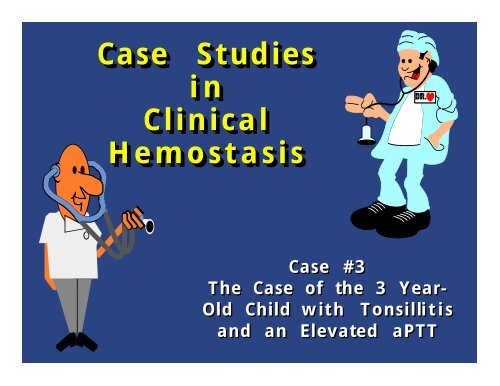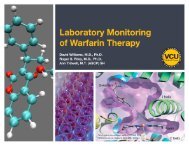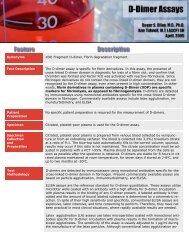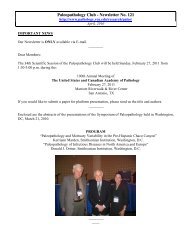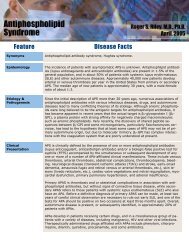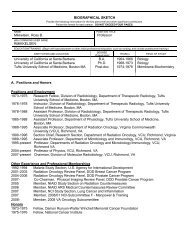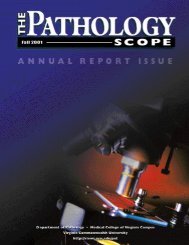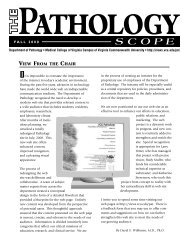Case Studies in Clinical Hemostasis Case Studies in ... - Pathology
Case Studies in Clinical Hemostasis Case Studies in ... - Pathology
Case Studies in Clinical Hemostasis Case Studies in ... - Pathology
You also want an ePaper? Increase the reach of your titles
YUMPU automatically turns print PDFs into web optimized ePapers that Google loves.
<strong>Case</strong> <strong>Studies</strong><br />
<strong>in</strong><br />
Cl<strong>in</strong>ical<br />
<strong>Hemostasis</strong><br />
<strong>Case</strong> #3<br />
The <strong>Case</strong> of the 3 Year-<br />
Old Child with Tonsillitis<br />
and an Elevated aPTT
Patient L.S.<br />
! Child with history of tonsillitis<br />
! Recurrent abdom<strong>in</strong>al distress and<br />
vomit<strong>in</strong>g<br />
! Normal birth and development, no<br />
other medical problems<br />
! No personal history of bleed<strong>in</strong>g or<br />
bruis<strong>in</strong>g<br />
! No family history of bleed<strong>in</strong>g disorder<br />
! Abnormal preoperative aPTT (34 sec)<br />
and bleed<strong>in</strong>g time (14.5 m<strong>in</strong>)<br />
! Referred to pediatric hematologist
Patient L.S.<br />
! What is the bleed<strong>in</strong>g time? How is it<br />
performed? How could the discrepant<br />
bleed<strong>in</strong>g time results be expla<strong>in</strong>ed?<br />
! What are common causes for an elevated<br />
aPTT?<br />
! What further laboratory studies should be<br />
performed?<br />
! What is the cause of the elevated aPTT <strong>in</strong><br />
L.S.?<br />
! Should the tonsillectomy be performed?<br />
What further therapy is <strong>in</strong>dicated?
The Bleed<strong>in</strong>g<br />
Time -<br />
Pot of Gold At<br />
The<br />
End Of The<br />
Ra<strong>in</strong>bow ?
Bleed<strong>in</strong>g Time<br />
❝ The time between the<br />
<strong>in</strong>fliction of a small<br />
<strong>in</strong>cision and the moment<br />
bleed<strong>in</strong>g stops ! ❞<br />
O’Brien, J.R.<br />
Am. J. Cl<strong>in</strong>. Pathol.<br />
4:272-285, 1951
What Determ<strong>in</strong>es The<br />
Bleed<strong>in</strong>g Time ?<br />
In vivo test of hemostatic function<br />
! Platelet function<br />
! Von Willebrand’s factor<br />
! Endothelial function<br />
! Coagulation factors<br />
! Circulat<strong>in</strong>g cellular elements
Bleed<strong>in</strong>g Time Procedure<br />
! Clean site with alcohol<br />
! Take medication history<br />
! Inflate blood pressure cuff to 40 mm<br />
! Make <strong>in</strong>cision with template<br />
! Beg<strong>in</strong> stopwatch<br />
! Blot <strong>in</strong>cision at 30 second <strong>in</strong>tervals<br />
! Red ➜ P<strong>in</strong>k ➜ Straw ➜ Endpo<strong>in</strong>t<br />
! Report <strong>in</strong> m<strong>in</strong>utes up to 15 m<strong>in</strong>utes
Bleed<strong>in</strong>g Time<br />
Reference Range<br />
! 2.5 - 10 m<strong>in</strong> - Blood 34:204-<br />
215,1969<br />
! 2.3 - 7.0 m<strong>in</strong> - AJCP 70:406-<br />
408,1978<br />
! 2.5 - 6.5 m<strong>in</strong> - Pediatrics 66:951-<br />
955,1980
Variability Of BT<br />
! Location & direction of <strong>in</strong>cision<br />
! Size and depth of <strong>in</strong>cision<br />
! Sk<strong>in</strong> characteristics<br />
! Venous pressure<br />
! Preparation of site<br />
! Patient cooperation<br />
! Blott<strong>in</strong>g technique<br />
! Endpo<strong>in</strong>t variation
Effect Of Platelet Count On<br />
Bleed<strong>in</strong>g Time<br />
30<br />
Uremia<br />
Platelet Count (x 10 4 /µl)<br />
25<br />
20<br />
10<br />
5<br />
ASA<br />
von Willebrand's Disease<br />
..<br />
ITP<br />
Harker, L.A. and Slichter, S.J.<br />
NEJM 287:155, 1972<br />
0<br />
0<br />
10 20 30 40 > 60<br />
Bleed<strong>in</strong>g Time (M<strong>in</strong>.)
Cl<strong>in</strong>ical Applications<br />
Of Bleed<strong>in</strong>g Time<br />
! Diagnostic test for bleed<strong>in</strong>g<br />
disorders<br />
! Predict risk of perioperative<br />
hemorrhage<br />
! Therapeutic<br />
decision-mak<strong>in</strong>g<br />
for drugs and blood products
U.S. Bleed<strong>in</strong>g Times -<br />
1,000,000/Year<br />
~ $35,000,000/Year
The Bleed<strong>in</strong>g<br />
Time As A<br />
Diagnostic Tool<br />
In<br />
The Bleed<strong>in</strong>g<br />
Patient
Bleed<strong>in</strong>g Time As<br />
Diagnostic Tool<br />
! Nieuwenhuis, Akkerman, and Sixma. Blood<br />
70:620, 1987<br />
! Detailed evaluation of 145 patients with<br />
history of bleed<strong>in</strong>g disorder, prolonged<br />
bleed<strong>in</strong>g time, and normal platelet count<br />
von Willebrand’s<br />
Disease<br />
Abnormal<br />
Thromboxane<br />
Synthesis<br />
Platelet Storage<br />
Pool Disease<br />
Other<br />
Abnormalities
Use of the<br />
Bleed<strong>in</strong>g Time<br />
to<br />
Predict<br />
Perioperative<br />
Hemorrhage
Always Get A<br />
Bleed<strong>in</strong>g History<br />
Before A<br />
Procedure !!
Preoperative Coagulation<br />
Test<strong>in</strong>g<br />
! Rohrer, Michelotti, and Nahrwold. Ann. Surg.<br />
208, 554, 1988<br />
! Efficacy of screen<strong>in</strong>g tests compared to<br />
efficacy of tests <strong>in</strong>dicated by history and/or<br />
physical examiantion<br />
! 1119 tests (BT, PT, PTT, PC) <strong>in</strong> 282 patients<br />
! 514 screen<strong>in</strong>g tests <strong>in</strong> 282 patients, 4.1%<br />
abnormal, none cl<strong>in</strong>ically significant<br />
! 605 <strong>in</strong>dicated tests, 7.4% abnormal<br />
! 44% of PT and PTTs, 59% of PCs, and 38% of<br />
BTs could be safely elim<strong>in</strong>ated, sav<strong>in</strong>g<br />
$370,000/year
Bleed<strong>in</strong>g Time As A<br />
Preoperative Screen<strong>in</strong>g Test<br />
! Barber et al. Am. J. Med. 78:761, 1985<br />
! Reviewed 1,941 bleed<strong>in</strong>g times performed as<br />
part of rout<strong>in</strong>e preoperative screen dur<strong>in</strong>g a six-<br />
month period<br />
! Prolonged bleed<strong>in</strong>g times (> 10 m<strong>in</strong>.) found <strong>in</strong><br />
110 patients (5.6%)<br />
! Bleed<strong>in</strong>g risk factors identified <strong>in</strong> 83/110<br />
patients (75%)<br />
! Only 2/27 patients without risk factors severely<br />
prolonged bleed<strong>in</strong>g times (> 20 m<strong>in</strong>.)
Applications<br />
of Bleed<strong>in</strong>g<br />
Time In<br />
Plann<strong>in</strong>g Drug<br />
Therapy And<br />
The Use Of<br />
Blood<br />
Products
Bleed<strong>in</strong>g Time As A<br />
Therapeutic Guide<br />
! Post-operative cardiopulmonary bypass -<br />
Platelet dysfunction versus mechanical problem<br />
! VWD - Resposne to DDAVP<br />
! Bleed<strong>in</strong>g associated with medications affect<strong>in</strong>g<br />
platelet function<br />
! Bleed<strong>in</strong>g associated with uremia - Response to<br />
DDAVP, estrogens, cryoglobul<strong>in</strong>, or dialysis<br />
! Bleed<strong>in</strong>g <strong>in</strong> patients with acute alcohol<br />
<strong>in</strong>toxication
The Bleed<strong>in</strong>g Time -<br />
Neither Pariah Nor<br />
Panacea<br />
Douglas Triplett, M.D.
Patient L.S.<br />
Repeated <strong>Studies</strong><br />
600<br />
20<br />
50<br />
20<br />
THOU/uL<br />
500<br />
400<br />
300<br />
200<br />
100<br />
●<br />
Seconds<br />
15<br />
10<br />
5<br />
●<br />
Seconds<br />
45<br />
40<br />
35<br />
30<br />
25<br />
●<br />
M<strong>in</strong>utes<br />
15<br />
10<br />
5<br />
●<br />
0<br />
PLTS<br />
0<br />
PT<br />
20<br />
aPTT<br />
0<br />
Bleed<strong>in</strong>g Time
Contact<br />
Factors<br />
- Charged<br />
Surface<br />
Modern Concept<br />
of Coagulation<br />
XI XI<br />
XIa XIa<br />
VII<br />
IX IX<br />
IXa IXa<br />
Tissue<br />
Factor<br />
Injured<br />
Tissue<br />
VIII<br />
VII<br />
XX<br />
Xa Xa<br />
V<br />
Prothromb<strong>in</strong><br />
Thromb<strong>in</strong>
Causes of Elevated aPTT<br />
! Hepar<strong>in</strong> adm<strong>in</strong>istration<br />
! Factor deficiency<br />
II, V, VIII, IX, XI, XII<br />
! Hypofibr<strong>in</strong>ogenemia (< 100 mg/dL)<br />
! Specific <strong>in</strong>hibitors<br />
! Non-specific<br />
<strong>in</strong>hibitors<br />
! Antithrombotic substances (FDPs)<br />
! Dissem<strong>in</strong>ated <strong>in</strong>travascular coagulation<br />
! Vitam<strong>in</strong> K deficiency
aPTT Inhibitor Screen<br />
Normal Plasma<br />
Patient Plasma<br />
1:1<br />
+<br />
Incubate<br />
Factor Deficiency - PT Corrected<br />
Factor Inhibitor - PT Uncorrected<br />
Perform<br />
Prothromb<strong>in</strong><br />
Time
aPTT Inhibitor Screen<br />
Mixture<br />
Un<strong>in</strong>cubated<br />
INTR<br />
Incubated<br />
INTR<br />
Normal Plasma<br />
23.6 sec<br />
-<br />
24.7 sec<br />
-<br />
Patient Plasma<br />
36.4 sec<br />
-<br />
45.5 sec<br />
-<br />
1 Normal:1<br />
Patient<br />
28.5 sec<br />
CRCT<br />
35.6 sec<br />
NCRCT<br />
1 Normal:4<br />
Patient<br />
32.9 sec<br />
NCRCT<br />
44.8 sec<br />
NCRCT<br />
4 Normal: 1<br />
Patient<br />
26.0 sec<br />
CRCT<br />
34.0 sec<br />
CRCT
Non-Specific<br />
Coagulation Inhibitor<br />
! Common <strong>in</strong> children with recurrent<br />
URI treated with repeated courses of<br />
antibiotics<br />
! Rarely associated with cl<strong>in</strong>ical<br />
bleed<strong>in</strong>g<br />
! Usually resolve with time<br />
! Exclusion of lupus anticoagulant, vWD,<br />
and congenital factor deficiencies<br />
essential
<strong>Case</strong> <strong>Studies</strong><br />
<strong>in</strong><br />
Cl<strong>in</strong>ical<br />
<strong>Hemostasis</strong><br />
<strong>Case</strong> #3<br />
The End


